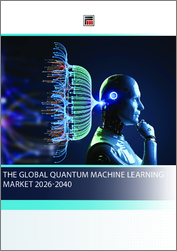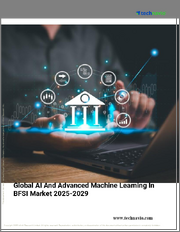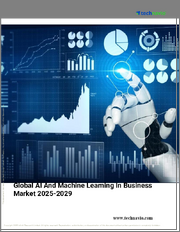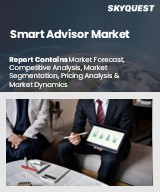
|
시장보고서
상품코드
1734000
세계의 양자 머신러닝(QML) 시장(2026-2040년)The Global Quantum Machine Learning Market 2026-2040 |
||||||
양자 머신러닝(QML)은 양자 역학의 고유한 특성인 중첩, 얽힘, 양자 간섭을 이용하여 고전 컴퓨터보다 기하급수적으로 빠른 속도로 머신러닝 문제를 해결할 수 있는 잠재력을 가지고 있습니다. 양자 머신러닝은 양자 알고리즘이 양자 중첩을 통해 방대한 데이터세트를 동시에 처리하고 여러 계산을 병렬로 수행할 수 있도록 하는 계산 지능의 패러다임 전환을 의미합니다. 0과 1의 결정적인 상태로 존재하는 고전 비트와 달리, 양자 비트(qubit)는 중첩된 상태로 존재할 수 있기 때문에 양자 컴퓨터는 여러 해답의 경로를 동시에 탐색할 수 있습니다. 이러한 양자 컴퓨터의 장점은 최적화 문제, 패턴 인식, 머신러닝 애플리케이션의 핵심인 복잡한 데이터 분석 작업에서 특히 두드러집니다.
이 분야에는 양자 프로세서를 사용하여 고전 알고리즘을 가속화하는 양자 강화 머신러닝, 양자 역학적 특성을 활용한 완전히 새로운 알고리즘인 양자 네이티브 머신러닝 등 여러 가지 중요한 접근법이 포함되어 있습니다. 양자 신경망, 양자 지원 벡터 머신, 양자 강화 학습은 AI 시스템의 학습 방법과 의사결정 방식을 근본적으로 바꿀 수 있는 새로운 방법입니다.
현재 구현은 양자 프로세서가 특정 계산 작업을 처리하고 고전 컴퓨터가 데이터 전처리, 후처리 및 시스템 제어를 관리하는 양자 고전 하이브리드 시스템이 주를 이루고 있습니다. 이 접근 방식은 노이즈, 디코히어런스, 양자 비트 수 제한과 같은 현재 양자 하드웨어의 한계를 완화하면서 두 패러다임의 장점을 최대한 활용합니다.
양자 머신러닝이 큰 이점을 가져다 줄 수 있는 수많은 고부가가치 응용 분야로 시장의 잠재력은 무궁무진합니다. 금융 기관은 포트폴리오 최적화, 위험 분석, 사기 탐지 등에 사용되는 양자 알고리즘을 연구하고 있으며, 여러 시장 시나리오를 동시에 처리할 수 있는 능력으로 인해 우수한 투자 전략을 수립할 수 있습니다. 의료 및 제약 기업에서는 양자 컴퓨터가 분자 간 상호작용을 전례 없는 정확도로 시뮬레이션할 수 있는 가능성이 있기 때문에 양자를 이용한 신약 개발, 단백질 폴딩 예측, 맞춤형 의료에의 적용이 검토되고 있습니다.
제조 부문에서는 공급망 관리, 품질 관리, 예지보전을 위한 양자 최적화가 평가받고 있으며, 사이버 보안 분야에서는 양자 내암호화 기술과 첨단 위협 탐지 시스템이 적용되고 있습니다. 이 기술의 잠재력은 기후 모델링, 교통 최적화, 과학 연구 등 기존 컴퓨터로는 한계가 있는 분야로 확장되고 있습니다.
본 보고서에서는 50-1,000 양자 비트의 양자 시스템을 특징으로 하는 현재의 Noisy Intermediate-Scale Quantum(NISQ) 시대를 살펴봅니다. 이러한 양자 시스템은 아직 보편적인 양자 우위를 보여주지는 못하지만, 복잡한 QML 알고리즘을 안정적으로 실행할 수 있는 내결함성 양자 컴퓨터로 가는 중요한 디딤돌이 될 수 있습니다.
주요 과제는 환경 간섭으로 인해 양자 상태가 빠르게 저하되는 양자 디코히어런스, 고전적 계산을 능가하는 양자 오류율, 양자 프로그래밍 전문가 부족 등입니다. 또한, 많은 기업들에게 하드웨어 비용이 여전히 비싸기 때문에 클라우드 기반 액세스 모델이나 QaaS(Quantum-as-a-Service)가 필요하게 되었습니다.
경쟁 구도에는 양자 하드웨어 및 양자 소프트웨어 플랫폼을 개발하는 대형 기술 기업, 양자 컴퓨팅 전문 기업, 기존 제품에 양자 기능을 통합하는 전통 기술 기업 등이 있습니다. 정부 투자, 학술 연구 프로그램, 벤처 캐피탈의 자금 지원으로 개발 일정과 상업적 활용이 가속화되고 있습니다.
세계의 양자 머신러닝(QML) 시장에 대해 조사 분석했으며, 시장 규모와 예측, 알고리즘 및 소프트웨어 동향, 투자 및 자금 조달 에코시스템, 주요 기업 49개사의 프로필 등의 정보를 전해드립니다.
목차
제1장 주요 요약
- 양자 머신러닝 시장 촉진요인
- QML 알고리즘과 소프트웨어
- 머신러닝에서 양자 머신러닝으로
- QML 단계
- 이점
- 과제
- QML 로드맵
제2장 소개
- 양자 머신러닝이란?
- 고전적 컴퓨팅 패러다임과 양자 컴퓨팅 패러다임
- 양자 역학 원리
- 머신러닝 기초
- 교차점 : 양자와 ML을 결합하는 이유
- 시장의 진화
- 이 분야 현황
- 용도와 이용 사례
- 과제와 한계
- 기술과 성능 로드맵
제3장 QML 알고리즘과 소프트웨어
- 머신러닝
- 머신러닝 유형
- 양자 딥러닝과 양자 신경망
- 양자 역전파
- QML의 Transformer
- QDL의 Perceptron
- ML 데이터세트
- 양자 암호화
- 양자 고전 하이브리드 머신러닝과 진정한 QML의 길
- 최적화 방법
- QML-over-the-Cloud와 QML-as-a-Service
- QML의 보안과 프라이버시
- AI, 머신러닝, 딥러닝, 양자 컴퓨팅
- 트레이닝과 추론 단계의 QML 취약성 증대
- QML Cloud와 QML-as-a-Service 보안
- 특허 상황
- QML 아키텍처 보안
- 기업
제4장 QML 하드웨어와 인프라
- 개요
- 로드맵
- 비용
- 양자 어닐링
- NISQ 컴퓨터와 QML
- NISQ를 넘어선 QML
- QML를 이용한 양자 하드웨어 제조와 최적화
- 머신러닝과 QRNG
제5장 QML 시장과 용도
- QML 기회
- 금융·은행
- 개요
- 용도
- 기업
- 헬스케어·생명과학
- 개요
- 용도
- 센서
- 맞춤형 의료
- Drug Discovery
- 제약·QML
- 기업
- 제조
- 개요
- 용도
- 기타 용도
- 산업 횡단적인 QML 혜택 분석
- 시장 규모와 성장 예측(2026-2040년)
- 지역 시장
- 북미
- 유럽
- 아시아태평양
- 기타 지역
- 지역 투자와 정책 범위 조
- QML 시장 세분화
- 기술 유형별
- 응용 분야별
- 시장 촉진요인과 억제요인
- QML 기술 준비도 평가
- 시장 성장 시나리오
제6장 투자와 자금 조달
- 벤처 캐피털과 민간투자 동향
- 정부의 자금 지원과 국가의 대처
- 기업 연구개발 투자
제7장 기업 개요(기업 47개사 프로파일)
제8장 용어집
제9장 조사 방법
제10장 참고문헌
ksm 25.06.13Quantum Machine Learning (QML) harnesses the unique properties of quantum mechanics-superposition, entanglement, and quantum interference-to potentially solve machine learning problems exponentially faster than classical computers. Quantum Machine Learning represents a paradigm shift in computational intelligence, where quantum algorithms can process vast datasets simultaneously through quantum superposition, enabling multiple calculations to occur in parallel. Unlike classical bits that exist in definitive states of 0 or 1, quantum bits (qubits) can exist in superposition states, allowing quantum computers to explore multiple solution paths simultaneously. This quantum advantage becomes particularly pronounced in optimization problems, pattern recognition, and complex data analysis tasks that form the core of machine learning applications.
The field encompasses several key approaches including quantum-enhanced machine learning, where classical algorithms are accelerated using quantum processors, and quantum-native machine learning, where entirely new algorithms leverage quantum mechanical properties. Quantum neural networks, quantum support vector machines, and quantum reinforcement learning represent emerging methodologies that could fundamentally transform how artificial intelligence systems learn and make decisions.
Current implementations focus on hybrid quantum-classical systems, where quantum processors handle specific computational tasks while classical computers manage data preprocessing, post-processing, and system control. This approach maximizes the strengths of both paradigms while mitigating current quantum hardware limitations such as noise, decoherence, and limited qubit counts.
The market potential spans numerous high-value applications where quantum machine learning could provide significant advantages. Financial institutions are exploring quantum algorithms for portfolio optimization, risk analysis, and fraud detection, where the ability to process multiple market scenarios simultaneously could yield superior investment strategies. Healthcare and pharmaceutical companies are investigating quantum-enhanced drug discovery, protein folding prediction, and personalized medicine applications, where quantum computers could simulate molecular interactions with unprecedented accuracy.
Manufacturing sectors are evaluating quantum optimization for supply chain management, quality control, and predictive maintenance, while cybersecurity applications include quantum-resistant cryptography and advanced threat detection systems. The technology's potential extends to climate modeling, traffic optimization, and scientific research applications where classical computational limitations currently constrain progress.
The report examines the current Noisy Intermediate-Scale Quantum (NISQ) era, characterized by quantum systems with 50-1000 qubits that exhibit significant noise and limited error correction. While these systems cannot yet demonstrate universal quantum advantage, they serve as crucial stepping stones toward fault-tolerant quantum computers capable of running complex QML algorithms reliably.
Key challenges include quantum decoherence, where quantum states deteriorate rapidly due to environmental interference, quantum error rates that currently exceed classical computation, and the scarcity of quantum programming expertise. Hardware costs remain prohibitive for most organizations, necessitating cloud-based access models and quantum-as-a-service offerings.
The competitive landscape includes technology giants developing quantum hardware and software platforms, specialized quantum computing companies, and traditional technology firms integrating quantum capabilities into existing products. Government investments, academic research programs, and venture capital funding are accelerating development timelines and commercial applications.
Report contents include:
- Detailed market evolution analysis from 2020 through 2040
- Comprehensive pros and cons assessment of quantum machine learning
- Technology and performance roadmap with key development milestones
- Market segmentation by technology type and application sectors
- Growth projections with multiple scenario analysis
- Technology readiness assessment across different quantum platforms
- Algorithm and Software Landscape
- Machine learning fundamentals and quantum integration approaches
- Comprehensive analysis of machine learning types and quantum applications
- Quantum deep learning and quantum neural network architectures
- Training methodologies for quantum neural networks
- Applications and use cases for quantum neural networks across industries
- Neural network types suitable for quantum implementation
- Quantum generative adversarial networks development and applications
- Quantum backpropagation techniques and optimization methods
- Transformers implementation in quantum machine learning systems
- Perceptrons in quantum deep learning architectures
- Dataset characteristics and quantum data encoding requirements
- Quantum encoding schemes and their performance characteristics
- Hybrid quantum/classical ML development pathways
- Advanced optimization techniques for quantum machine learning
- Cloud-based QML services and quantum-as-a-service platforms
- Security and privacy considerations in quantum machine learning
- Patent landscape analysis for QML algorithms and implementations
- Comprehensive profiles of leading QML software companies
- Hardware Infrastructure Analysis
- Quantum computing hardware overview and market assessment
- Hardware development roadmap through 2040
- Comprehensive cost analysis for quantum computing systems
- Quantum annealing systems and their ML applications
- Comparison between quantum annealing and gate-based systems
- NISQ computers specifications for machine learning applications
- Error rates and coherence times across different platforms
- Hardware optimization using quantum machine learning techniques
- Quantum random number generators for ML applications
- Leading hardware companies and their technology approaches
- Application Sector Analysis
- Comprehensive QML opportunities across multiple industries
- Financial services and banking applications including risk analysis and optimization
- Healthcare and life sciences applications for drug discovery and diagnostics
- Sensor integration for quantum ML-based diagnostic systems
- Personalized medicine implementation using quantum algorithms
- Pharmaceutical applications and drug discovery acceleration
- Manufacturing sector applications for optimization and quality control
- Additional applications across various industries and use cases
- Cross-industry benefit analysis and performance comparisons
- Market Forecasts and Projections
- Global QML market size projections by year (2026-2040)
- Regional market growth rates and compound annual growth rate analysis
- Market segmentation by technology type with revenue projections
- Application sector segmentation with detailed revenue forecasts
- Market drivers versus restraints impact analysis
- Technology readiness assessment matrix across platforms
- Hardware versus software revenue split projections
- Market penetration rates by industry sector
- Technology adoption milestones and timeline analysis
- Market growth scenarios including conservative, base, and optimistic projections
- Technology maturity curve analysis and commercial viability assessment
- Investment and Funding Ecosystem
- Venture capital investment trends in QML companies
- Government funding programs and national quantum initiatives
- Corporate R&D spending patterns and investment strategies
- Investment trends segmented by technology focus areas
- Public-private partnership models and collaboration frameworks
- Company Profiles and Competitive Analysis
- Comprehensive profiles of 49 leading companies in the QML ecosystem. Companies profiled include AbaQus, Adaptive Finance, Aliro Quantum, Amazon/AWS, Atom Computing, Baidu Inc., BlueQubit Inc., Cambridge Quantum Computing (CQC), D-Wave, GenMat, Google Quantum AI, IBM, IonQ, Kuano, MentenAI, MicroAlgo, Microsoft, Mind Foundry, Mphasis, Nordic Quantum Computing Group, ORCA Computing, Origin Quantum Computing Technology, OTI Lumionics, Oxford Quantum Circuits, Pasqal, PennyLane/Xanadu, planqc GmbH, Polaris Quantum Biotech (POLARISqb), ProteinQure, and more....
TABLE OF CONTENTS
1. EXECUTIVE SUMMARY
- 1.1. Quantum Machine Learning Market Drivers
- 1.2. Algorithms and Software for QML
- 1.3. Machine Learning to Quantum Machine Learning
- 1.4. QML Phases
- 1.4.1. The First Phase of QML
- 1.4.2. The Second Phase of QML
- 1.5. Advantages
- 1.5.1. Improved Optimization and Generalization
- 1.5.2. Quantum Advantage
- 1.5.3. Training Advantages and Opportunities
- 1.5.4. Quantum Advantage and ML
- 1.5.5. Improved Accuracy
- 1.6. Challenges
- 1.6.1. Costs
- 1.6.2. Nascent Technology
- 1.6.3. Training
- 1.6.4. Quantum Memory Issues
- 1.7. QML Roadmap
2. INTRODUCTION
- 2.1. What is Quantum Machine Learning?
- 2.2. Classical vs. Quantum Computing Paradigms
- 2.3. Quantum Mechanical Principles
- 2.4. Machine Learning Fundamentals
- 2.5. The Intersection: Why Combine Quantum and ML?
- 2.6. Market evolution
- 2.7. Current State of the Field
- 2.8. Applications and Use Cases
- 2.9. Challenges and Limitations
- 2.10. Technology and Performance Roadmap
3. QML ALGORITHMS AND SOFTWARE
- 3.1. Machine Learning
- 3.2. Types of Machine Learning
- 3.3. Quantum Deep Learning and Quantum Neural Networks
- 3.3.1. Quantum Deep Learning
- 3.3.2. Training Quantum Neural Networks
- 3.3.3. Applications for Quantum Neural Networks
- 3.3.4. Types of Neural Networks
- 3.3.5. Quantum Generative Adversarial Networks
- 3.4. Quantum Backpropagation
- 3.5. Transformers in QML
- 3.6. Perceptrons in QDL
- 3.7. ML Datasets
- 3.8. Quantum Encoding
- 3.9. Hybrid Quantum/Classical ML and the Path to True QML
- 3.9.1. Quantum Principal Component Analysis
- 3.9.1.1. Handling Larger Data Sets
- 3.9.1.2. Dimensionality Reduction
- 3.9.1.3. Uses of Grover's Algorithm
- 3.9.1. Quantum Principal Component Analysis
- 3.10. Optimization Techniques
- 3.11. QML-over-the-Cloud and QML-as-a-Service
- 3.12. Security and Privacy in QML
- 3.13. AI, Machine Learning, Deep Learning and Quantum Computing
- 3.14. Growing QML Vulnerabilities During the Training and Inference Phases
- 3.15. Security on QML Clouds and QML-as-a-Service
- 3.16. Patent Landscape
- 3.16.1. Quantum Machine Learning Patents by Type (2020-2025)
- 3.16.2. QML Algorithms
- 3.17. Security on QML Architecture
- 3.18. Companies
4. QML HARDWARE AND INFRASTRUCTURE
- 4.1. Overview
- 4.2. Roadmap
- 4.3. Costs
- 4.4. Quantum Annealing
- 4.4.1. Quantum Annealing vs. Gate-based Systems
- 4.4.2. Companies
- 4.5. NISQ Computers and QML
- 4.5.1. NISQ System Specifications for QML
- 4.5.2. Companies
- 4.6. QML beyond NISQ
- 4.7. Fabricating and Optimizing Quantum Hardware Using QML
- 4.8. Machine Learning and QRNGs
5. QML MARKETS AND APPLICATIONS
- 5.1. QML Opportunities
- 5.2. Finance and Banking
- 5.2.1. Overview
- 5.2.2. Applications
- 5.2.3. Companies
- 5.3. Healthcare and Life Sciences
- 5.3.1. Overview
- 5.3.2. Applications
- 5.3.3. Sensors
- 5.3.4. Personalized Medicine
- 5.3.5. Drug Discovery
- 5.3.6. Pharma and QML
- 5.3.7. Companies
- 5.4. Manufacturing
- 5.4.1. Overview
- 5.4.2. Applications
- 5.5. Other Applications
- 5.6. Cross-Industry QML Benefit Analysis
- 5.7. Market Size and Growth Projections (2026-2040)
- 5.8. Regional Market
- 5.8.1. North America
- 5.8.2. Europe
- 5.8.3. Asia-Pacific
- 5.8.4. Rest of World
- 5.8.5. Regional Investment and Policy Framework
- 5.9. QML Market Segmentation
- 5.9.1. By Technology Type
- 5.9.2. By Application Sector
- 5.10. Market Drivers vs. Restraints
- 5.11. QML Technology Readiness Assessment
- 5.12. Market Growth Scenarios
6. INVESTMENT AND FUNDING
- 6.1. Venture Capital and Private Investment Trends
- 6.2. Government Funding and National Initiatives
- 6.3. Corporate R&D Investment



















